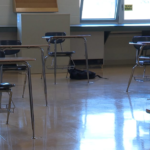
BURLINGTON, Vt. (WCAX) – Schools are addressing student mental health after a few tough years of learning throughout the pandemic.
There’s new guidance for schools pertaining to suicide prevention after data shows an uptick in attempts by students.
According to the 2021 youth risk behavior survey, 35% of high school students experience poor mental health. The Department of Mental Health (DMH) says 7% of students attempted suicide in the past year – a number schools and the state alike want to reduce.
Central Caledonia Supervisory Union superintendent Mark Tucker says some students fell behind academically, something they’re working on. But more notably, he says, students are having socialization issues.
“The school community has been fractured by the pandemic experience,” said Tucker.
Meanwhile, Linnea Jahn of the Franklin West Supervisory Union says they are looking to make mental health care more accessible.
“I know that teachers have told me they feel like they are seeing an increase in the classroom of students expressing the need for mental health support,” Jahn said.
Both supervisory unions are using a $200,000 grant from the state to initiate Talkspace in their community, which is virtual text and talk therapy for students and teachers.
Tucker said, “That’s gonna take a while to work out of the system. So that’s why, you know, finding ways to continue to provide support for kids and staff are going to be important.”
“It removes the transportation barrier where we’re located. In our town, there are not many counseling centers and so folks have to travel which is another burden on families,” said Jahn.
Both supervisory unions have dozens of students signed up for the program.
These efforts are part of a wider initiative to bring awareness to mental health needs in schools with the Department of Mental Health noting schools face overwhelming challenges among staffing shortages and insufficient funding.
DMH’s Chris Allen says while there isn’t a high rate of suicide death among teens in Vermont, there is a high rate of suicide attempts or self-harming behavior.
New protocols being brought forth to the legislature from the state include training staff on suicide prevention and awareness, how to respond to a student who’s confiding in them with these thoughts, and how to reintegrate a student back on campus in a positive way after a suicide attempt.
“This protocol is really, really foundational for what’s needed in schools for a coordinated, helpful response to students that are either expressing suicidal thoughts of wanting to die and not be alive, and really like, ways to get ahead of that as well,” said Allen. “The major warning sign is whenever someone shares they have thoughts of wanting to die or not be alive – that is a critical moment where intervention is needed. More information is needed from that threat and it’s to be taken serious.”
Allen says every school has different resources, so they’d have to adapt as necessary for their operations.
Back on the school level, the team in the Franklin West Supervisory Union says it’s important for anyone interacting with students to be well-trained for warning signs around suicide or self-harm.
Jahn said, “I hope there’s increased access and I think school can’t be the only source of addressing mental health needs. So I would love to see more funding going, yeah, yeah, the mental health resources, but also to schools because this is where you are.”
See here for information on the suicide hotline, as well as other warning signs from the Department of Mental Health.
